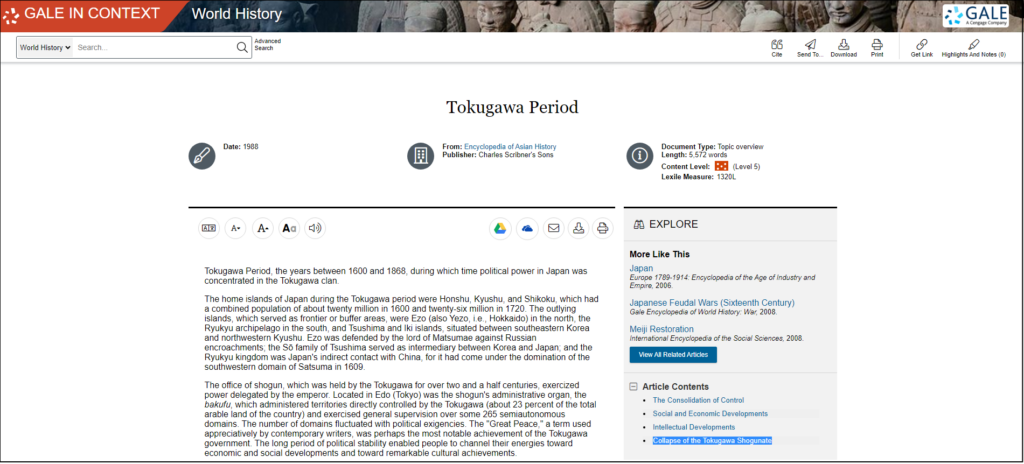| By J. Robert Parks |
The Meiji Restoration, one of the pivotal periods in Japanese history, began in 1868 with the overthrow of the Tokugawa shogunate and the re-establishment of imperial rule. The new emperor, Mutsuhito, was only 16 years old when he came to power, so he initially ruled in conjunction with advisors and powerful officials. Over the next 54 years, however, he helped usher Japan into the modern era. Mutsuhito adopted the name Meiji (which means “enlightened rule”), and one of the key early events of the Meiji Restoration was the Japan Land Tax Reform Act, which was enacted 150 years ago this month. It did away with the inequitable tax system of the Tokugawa Period and laid the foundation for the capitalist economy that would become a hallmark of Japan in the twentieth century. Educators and librarians looking to understand the development of modern Japanese society will find a wealth of resources in Gale In Context: World History.
The Tokugawa Period, which came before the Meiji, is associated with two aspects of Japanese culture: the closing off of the country from the outside world and the feudal system that was dominated by the Tokugawa shogun and the daimyo lords under him. Both aspects were true for much of the Tokugawa Period, but Japan became a much freer economic society toward its end. Tenant farmers could make a profit and start to accumulate wealth. Merchants could take advantage of the safety and stability of the Tokugawa rule to sell and trade throughout the country. This created a framework in which the Meiji Restoration could flourish.
The first three years of the Meiji Restoration were spent transforming the political structure of the country. This occurred in multiple stages, but the result was that the daimyo were replaced with more-experienced administrators, typically samurai who had been administrators under Tokugawa rule. By the time the daimyo realized what was happening, the Meiji had formed an Imperial Guard of 10,000 fighters, and the daimyo had no military response. Thus, a centralized national government was born.
This was so successful that the country’s leaders felt secure enough to undertake the Iwakura Mission, a diplomatic as well as an educational trip. It was commissioned by the emperor, led by Iwakura Tomomi (hence its name), and involved more than 100 leaders, clerks, attendants, and students. It lasted from December 1871 to July 1873, traveling around the world and spending seven months in the United States and four months in Great Britain. The trip was designed to spread goodwill and also to understand the West and its political and economic systems.
Soon after the mission returned, the Japan Land Tax Reform Act was imposed. No longer were taxes paid in vegetables and other produce, which was both inequitable and cumbersome. Instead, the government determined the value of land parcels and then proceeded to issue over 100 million certificates of land ownership, which would be the basis for how taxes were levied. To head off opposition to the new system, the Meiji made it clear the tax revenue would be equal to what was collected under the Tokugawa, and that tax burdens would be uniform across the country. The result was that the tax burden rose for some Japanese, but it declined slightly for most farmers.
Other key economic developments during this period included the development of a new banking system, the building of the first railroads, and the connecting of major cities via telegraph lines. The country also became more Western, as it adopted a new constitution in 1889. Its author was Ito Hirobumi, who was a member of the Iwakura Mission and rose to become Japan’s first prime minister in 1885. The Meiji Constitution is seen as institutionalizing the rule of law in Japan.
In the following decades, the Meiji became more of a symbol of national unity and power rather than a forceful head of state, as Japan became a constitutional monarchy. Mutsuhito died in 1912, at a point when Japan’s power was growing and its expansionist foreign policy was threatening other world powers with which it would come into conflict.
About the Author
J. Robert Parks is a former professor and frequent contributor to Gale In Context: U.S. History and Gale In Context: World History who enjoys thinking about how our understanding of history affects and reflects contemporary culture.




